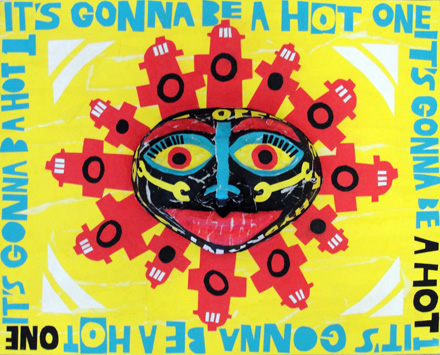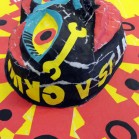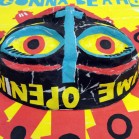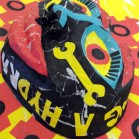



Paper Mache Mask • 20″x16″ • Private Collection
Pictured above is my swan project, completed during a week-long collage course. Based on the creative seed-planting process of the Dadaists, four random bits of inspiration were drawn from a hat (assuming people wear plastic bags as hats). I pulled two bits of text (“HEARD ON THE STREET” and “YOUTH PROGRAM”), a photo of a set of dentures soaking in a glass of water and a weather map depicting high temperatures across the United States. Our task was to create a paper mache mask combining the happenstance elements.
The convergence of those seemingly unrelated elements pointed me towards the idea of urban youth frolicking in an illegally opened fire hydrant on a hot summer day. The resulting mask may serve as a modern day, ceremonial, waterdance headdress. In addition to the overt references, including wrench and fireplug silhouettes and text (IT’S GONNA BE A HOT ONE” and “”OPENING A FIRE HYDRANT IS A CRIME”), the mask covertly suggests the shape of the sun and tribal (African, South American and North American) aesthetic elements.
Now that the scraps have settled, it’s time to be visited by three ghosts:
THE GHOST OF COLLAGE PAST
As I’ve recently crowed, my recent collage work has been influenced by contemporary artist, Matt Bovie. Prior collage work was more heavily influenced by the cut-paper compositions of Henri Matisse. For the past 15 years, I’ve been teaching collage in the middle school classroom, spurred by the work of Matisse, Romare Bearden and Barbara Kruger. Both as an instructor and producer of art, I’ve long appreciated the medium as being one in which compositional/design issues and decisions can be isolated, evaluated and revised quite efficiently.
THE GHOST OF COLLAGE PRESENT
I found this week to be rewarding and invigorating. The byproduct of the learning left me with a bundle of work including the above mask and the Cover Artist collection of modified books. Although I enjoy and appreciate the written word as much as visual art, incorporating text into compositions is not something that comes naturally. I am, however, quite pleased with the results of being challenged to do so, especially on and around the mask. I believe I stumbled upon a letter cutting technique that compliments the visual aesthetic as opposed to competing with it.
Although paper mache mask making has long been a component of my classroom instruction, I seldom considered it a vehicle for my own production. When challenged to participate in the construction of one, however, my appreciation of the craft grew. Not only did it offer a fresh way to consider three-dimensional design components, it allowed me to contemplate issues of identity, personification and anonymity.
THE GHOST OF COLLAGE YET TO COME
I believe that the week’s work will have a long-lasting impact on my personal work. I feel, for the first time, pleased with a process/technique of adding words to visual images. Attempts to do so in the past, via drawing and painting materials, always felt juvenile and oafish. I’m not sure that mask-making will be major component of my art-making repertoire, but I’m willing to leave the door open and the light on.
This week’s experience will have two direct impacts on my middle school art instruction. I look forward to revisiting and creating a lessons that marry text and imagery. Evidence of this happy marriage is all around us, including commercial and fine art, and it’s a mistake to ignore this union in the art classroom. I’m also leaning towards using modeling clay as a base form for a paper mache experience, which was the process utilized in the construction of the above mask. If my students respond negatively to these curriculum additions, I will blame the University of the arts.
In other words, blah blah blah.
 Entries (RSS)
Entries (RSS)